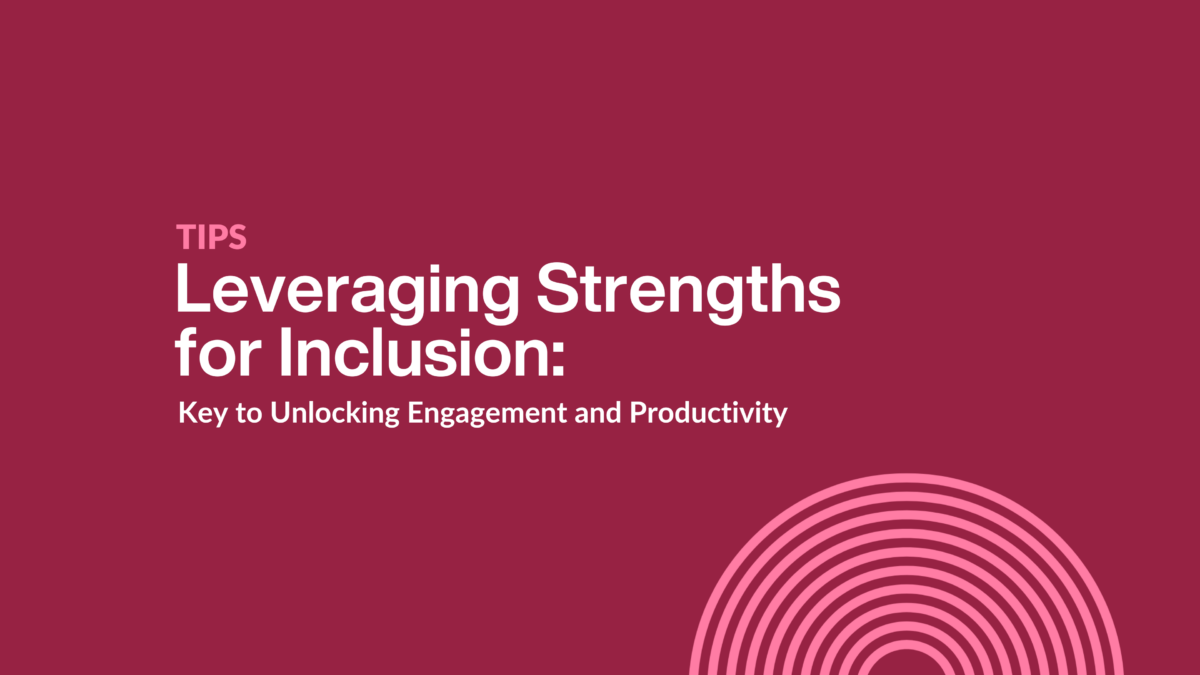Vicki Haverson , Leadership & Talent Consultancy, GatenbySanderson delivered an online session exploring strengths-based development, highlighting how understanding and leveraging strengths can create a more inclusive and impactful workplace. This article is part of a series focusing on inclusive leadership and strengths-based development. View more content on these topics below.
, Leadership & Talent Consultancy, GatenbySanderson delivered an online session exploring strengths-based development, highlighting how understanding and leveraging strengths can create a more inclusive and impactful workplace. This article is part of a series focusing on inclusive leadership and strengths-based development. View more content on these topics below.
Related content:
- Driving Impact through strengths-based development – webinar recording
- Focus-shift: develop your strengths rather than weaknesses to increase energy and value
- Leveraging Strengths for Inclusion: The Key to Unlocking Engagement and Productivity
- Cultural intelligence and inclusive leadership webinar – key takeaways
Leveraging Strengths for Inclusion: Key to Unlocking Engagement and Productivity.
Inclusion is more than just a buzzword—it’s about creating spaces where people feel seen, valued, and empowered to contribute their unique strengths. At its core, leveraging strengths for inclusion means recognising that every individual has something valuable to offer. It’s about honouring both similarities and differences by providing opportunities for people to do what they do best.
But how often do we truly get the chance to showcase our strengths at work?
The question, ‘How often do you get the opportunity to do what you do best at work?’ is, according to Gallup, a key driver of engagement. It also reveals a lot about how inclusive a workplace feels for employees. When people use their strengths, they not only feel more engaged but their work has a greater impact, benefiting both the individual and the organisation as a whole.
In most workplaces, responses to this question can vary greatly. Some may feel they frequently use their strengths, while others rarely have the opportunity. This diversity of experience is critical to recognise because being able to contribute your best work is foundational to creating a truly inclusive environment—one where individuals know their strengths are valued and have real impact.
Why Strengths Matter for Inclusion and Impact
Research shows that only two in five people feel they can fully utilise their strengths at work. Among leaders, this number is higher—around 60% report having the chance to play to their strengths every day, compared to only 27% of non-leaders. Those who do get the opportunity to use their strengths are four times more likely to feel understood and appreciated by their colleagues.
So, what does this mean in practice? When employees can apply their strengths, their work has a far-reaching impact on engagement, productivity, and overall team performance. Inclusion isn’t just about everyone having a seat at the table—it’s about ensuring that people can bring their best selves to work and have a real influence on outcomes.
The Power of a Strengths-Based Approach
Taking a strengths-based approach in the workplace has far-reaching benefits, both for individuals and organisations. Research from Gallup, Qualtrics, and Glassdoor consistently shows the positive impact:
- Employees are 6 times more engaged at work.
- Productivity increases by over 17%.
- Employees are 3 times more likely to report a high quality of life.
- They are 3 times more likely to feel like valued members of the team, comfortable being themselves at work.
- 82% agree that working from their strengths makes them feel appreciated as individuals.
Creating an environment where people feel seen, heard, and valued not only fosters a sense of belonging but also drives measurable outcomes, such as increased productivity, innovation, and retention. When people know their strengths are recognised and their contributions matter, they invest more in the organisation’s success.
Inclusion and Leadership: The Ripple Effect of Impact
Leaders play a critical role in fostering inclusive environments, but inclusion isn’t a one-size-fits-all approach. Everyone’s strengths are different, and their experiences at work are unique. A workplace where inclusion thrives recognises that individual strengths influence how people view the world and approach their work.
For example, if you’re someone who thrives on getting things done quickly, you might become frustrated with colleagues who prefer to take more time for reflection. This difference in approach can create friction if we aren’t aware of the lenses through which we view the world. Our strengths shape not only how we work but also how we perceive others’ contributions. This awareness is crucial for inclusion to have a lasting impact on both team dynamics and organisational success.
A team filled with strategic thinkers may generate great ideas but struggle with execution. Recognising these dynamics is essential to overcoming biases within teams, and it ensures that all members contribute meaningfully to the team’s overall impact. By leveraging everyone’s unique approach to problem-solving, leaders can create a more inclusive and high-impact team.
Tools and Models for Identifying Strengths and Driving Impact
Several tools are available to help individuals and teams identify and better understand their strengths, including CliftonStrengths and Wave Professional Styles. These tools provide a shared language for discussing strengths and create opportunities for more intentional conversations about what each person can bring to the table.
A useful model for driving impact is the Strengths, Energy, and Value Model, adapted from the Centre for Applied Positive Psychology. This model helps employees map their tasks against four quadrants based on how energised and impactful they feel:
- Energised and Impactful: Tasks that excite you and add significant value.
- Valuable but Tiresome: Important tasks that drain your energy.
- Tempting but Distracting: Fun but low-value tasks.
- Draining and Pointless: Tasks that deplete you and add little value.
Using this model helps teams align their strengths with impactful work, making sure people spend their time in the “energised and impactful” zone. It also opens the door to collaboration and task-swapping, ensuring that everyone is contributing to the team in ways that feel energising and meaningful.
Conversations as Catalysts for Inclusion and Impact
One of the most powerful ways to foster inclusion is by having open, strengths-based conversations. These dialogues are not only a way to better understand each team member’s unique contributions but also a key to unlocking impact. Leaders who prioritise these conversations create environments where people feel empowered to contribute their strengths.
A few key questions can guide these conversations:
- What activities at work make you feel most connected to your values?
- What strengths would you like to contribute more of to the team?
- What type of partner would best support your efforts?
- What is a personal or professional goal you’d like help with?
These questions encourage self-reflection, build trust, and create opportunities for deeper collaboration. By fostering these strengths-based conversations, teams can move toward a culture where inclusion leads to sustained, impactful success.
The Path Forward: Inclusion with Impact
Inclusion is not a destination but an ongoing journey that requires intentional effort. By focusing on strengths, leaders and teams can unlock real, measurable impact—whether in engagement, innovation, or overall performance. Leveraging strengths isn’t just a “nice-to-have”—it’s a powerful tool for ensuring that inclusion leads to meaningful outcomes for individuals and organisations alike.
The most important takeaway?
Start with yourself.
Reflect on your strengths, recognise your biases, and engage others in thoughtful conversations. When we do this, we create workplaces where inclusion drives impact, benefiting not just the individual but the entire organisation.
GatenbySanderson is the UK’s leading people advisory firm delivering executive search, including interim, and leadership & talent consultancy across public services, not for profit and education.
For more information, or to ask a question, please contact Vicki Haverson – vicki.haverson@gatenbysanderson.com
